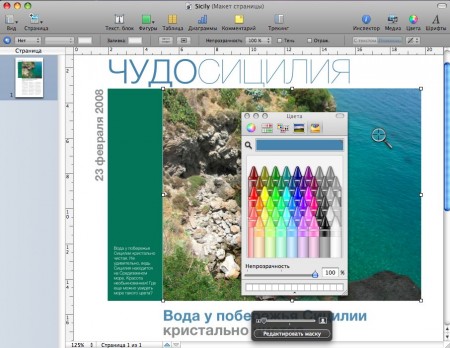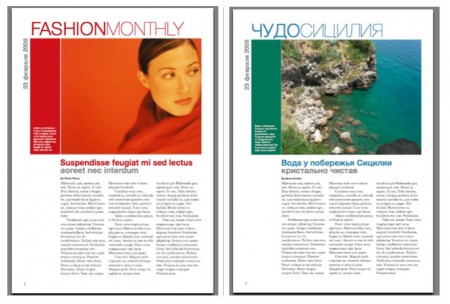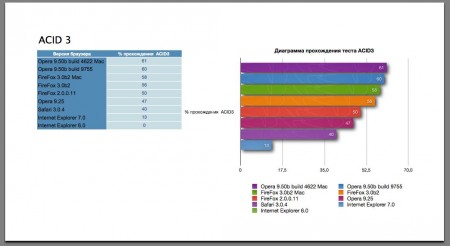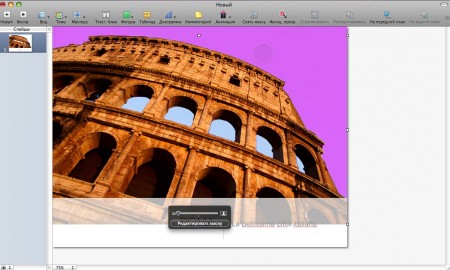Is there life on the Mac? Office
I decided to call the new cycle of articles differently, because I’ve finally moved to the Mac and somehow I don’t intend to move anywhere in the near future.
I am asked many questions about Macs, and I will try to answer them to the best of my knowledge in this area. I hope that you complement them with your wonderful comments.
In this part, I will talk about office programs, in particular, about native Mac applications iWork'08. I am not familiar with previous versions of this package, but I can say with confidence that this version pleases me immensely and I really like it. Of course, this is not the only office application for Macs. There is also Microsoft Office 2004 (a traal version of which is already preinstalled on computers) and 2008, released recently. There are other applications, for example, Neo Office - a free open-source product licensed under the GPL. I’ll talk about iWork, because I work most closely with these applications.
')
Immediately it should be said that this application is not for everyone. It is designed for ordinary users without any specific professional requirements. I would say that, unlike other office applications, iWork aims to graphically display information. Anyone who appreciates this new iWork will be very pleased. Although we all have different tasks and, accordingly, different requirements to the programs as tools for their implementation, I will try to describe the advantages and disadvantages of the programs included in iWork. In this, I will partially rely on Macworld articles to make my story more complete.
Text editor in iWork. The working window of the application with an open color bar looks like this:

According to Macworld:
Behind:
Vs:
You can read the full Macworld Pages review here .
My comments
When I made my choice, it was determined by two aspects: ease of use and compatibility with Microsoft Office formats. To begin, talk about ease. After Microsoft Office, this is a completely different user experience! For the first time in my life, I like templates and can be used because they are thought out and well made.
At last, I understood why the Address Book is for me. If you select the text processing mode in Pages, it contains many templates for letters, envelopes, resumes, business cards. Where were you before when we went through these very business letters at school and could not remember in what order to fill in the address? Now do not need to remember anything. You can simply drag the contact from the address book, and the address will fill in by itself (provided that this contact information is in the address book). At work, I often write letters, and this option has been very useful to me. I also do not see any problems with integration with email applications. Yes, the document itself will not be attached as an attachment, but it can be exported, for example, to PDF and sent.
I want to show a little bit what you can do in this program. I chose one of the page layouts and made a few of my changes. Added a photo, edited the headlines. Changed the colors of the headers and the rectangular block on the left near the photo. This is all done very quickly and simply. You can select and add a photo either using the media browser, or simply drag it from the Finder or the desktop. Text color changes in just a few clicks from the color bar. We take a magnifying glass, try the greenish color in the photo closer to the shore - fill a rectangular block with it, try the blue color away from the shore - and now the header color is ready. In my opinion, it turned out quite well (the original layout on the left, the result on the right).

Now about compatibility. For all the time I had no compatibility issues. Moreover, bearing in mind the problems with the compatibility of Microsoft Office 2007 with previous versions, which are solved, but cause a lot of trouble, I was waiting for a dirty trick. It simply cannot be that everything is so easily exported to office formats. Design does not go, everything opens, somehow strange. What is wrong here? What am I doing wrong?
To understand what this is about, I’ll tell you a little about my user experience with Microsoft products, in particular MSOffice 2007. I tried it first, and how surprised I was when I found out that there is no normal backward compatibility. It opens documents well saved in previous versions, but if in previous versions of Office you try to open documents in .docx format, in which the 2007th Office saves by default, nothing happens - the file simply will not open. The same with the compatible format 97-2003. At one time, this brought many unpleasant moments before the FileFormatConverter patch appeared, which helps the Office 2007 save documents in normal compatible formats that later versions of the Office can open. But here, not everything is so smooth. For the most part, this applies to Excel and PowerPoint. Colors of markers, tables, graphs are not always transferred correctly. You can spend a lot of time on paperwork and bringing them into a normal look, and then it turns out that in the previous version it all looks different, and it’s just awful. That's why I was very surprised when it turned out that Pages calmly opened both .doc documents and .docx, the design does not go, except that the colors become somewhat muffled, that's all.
Documents created in Pages can be exported in the following formats:

For a long time, the iWork package did not include the spreadsheet editor, but in iWork'08 it appeared to our great joy. I will say in advance that this program is not for everyone. For accountants, financiers, people using a spreadsheet editor for complex calculations, it is hardly suitable, but for all other Numbers this is a great program.
The Numbers working window with the Inspector window open on the diagram editing tab looks like this:

According to Macworld:
Behind:
Vs:
A full review of Numbers on Macworld can be read here .
My comments:
There are many functions that I do not use in Excel, but I will not calm down until the result of my labors and wars with tables looks good. In Excel, you had to spend a lot of time to bring the newly created table to mind. In Numbers, I am happy to use ready-made templates that are perfectly exported to Excel and look exactly the same there. There is another excellent feature in Numbers: if you select a column of numbers, the program automatically calculates the sum, minimum, maximum value and number of selected rows, and then the finished result with the formula can be dragged into any cell you choose. Now I really miss this when I work in Excel.
Numbers allows you to build great diagrams, which I actively use to visualize or graphically present information. For this article, I built a chart passing various Acid 3 test browser, based on the data from the atukai commentary to the Zigzag article "Acid 3 is ready!" Here's what happened:

Documents created in Numbers can be exported in the following formats:

About exporting it is worth noting that a document exported to Excel may look slightly different. For example, if on a page in Numbers there is one table, one graph or diagram, one text block, then in Excel it will be placed on one page. If there are several tables, charts and text blocks, then in Excel each table will be on a new page, on a separate page there will be diagrams with text captions, i.e. significantly increase the number of sheets.
A wonderful application for creating presentations. This is how the Keynote work window looks like when using the transparency feature:

I decided to continue the Italian theme and use the existing layouts to create illustrations for the article. The result was the following (on the left the initial version, on the right - after applying the transparency function):

My comments:
I do not get tired to admire this program, because it is impossible to praise it. Many wonderful templates that can be used as a foundation for creating your own presentation, improved animation and work with images. The program allows you to record a story for your presentation. I have not had time to try all the features of Keynote in full, so the review will be somewhat abbreviated. A full Keynote review can be found here .
Here is another slide layout where I added some text:

Keynote allows you to export the created presentation in the following formats:

Thanks for reading. Waiting for your comments.
I am asked many questions about Macs, and I will try to answer them to the best of my knowledge in this area. I hope that you complement them with your wonderful comments.
In this part, I will talk about office programs, in particular, about native Mac applications iWork'08. I am not familiar with previous versions of this package, but I can say with confidence that this version pleases me immensely and I really like it. Of course, this is not the only office application for Macs. There is also Microsoft Office 2004 (a traal version of which is already preinstalled on computers) and 2008, released recently. There are other applications, for example, Neo Office - a free open-source product licensed under the GPL. I’ll talk about iWork, because I work most closely with these applications.
')
Immediately it should be said that this application is not for everyone. It is designed for ordinary users without any specific professional requirements. I would say that, unlike other office applications, iWork aims to graphically display information. Anyone who appreciates this new iWork will be very pleased. Although we all have different tasks and, accordingly, different requirements to the programs as tools for their implementation, I will try to describe the advantages and disadvantages of the programs included in iWork. In this, I will partially rely on Macworld articles to make my story more complete.
Pages
Text editor in iWork. The working window of the application with an open color bar looks like this:

According to Macworld:
Behind:
- numerous new templates;
- A new formatting panel makes it easy to format documents;
- various text processing and page layouts;
- improved tools for editing images, tables, diagrams;
- a useful feature of recording and viewing changes (Track Changes or Tracking in the Russian version);
- almost complete compatibility of documents with Microsoft Word.
Vs:
- poor integration with Mail;
- two users can open the document at the same time and start editing it, but the program will not warn about it - complicates the process of working together on the document;
- charts are not dynamically linked to tabular data, i.e. when updating the data in the table, the diagram will remain unchanged;
- tracking does not work for changes applied to images, tables, and charts;
- on small monitors, the work area will be quite full.
You can read the full Macworld Pages review here .
My comments
When I made my choice, it was determined by two aspects: ease of use and compatibility with Microsoft Office formats. To begin, talk about ease. After Microsoft Office, this is a completely different user experience! For the first time in my life, I like templates and can be used because they are thought out and well made.
At last, I understood why the Address Book is for me. If you select the text processing mode in Pages, it contains many templates for letters, envelopes, resumes, business cards. Where were you before when we went through these very business letters at school and could not remember in what order to fill in the address? Now do not need to remember anything. You can simply drag the contact from the address book, and the address will fill in by itself (provided that this contact information is in the address book). At work, I often write letters, and this option has been very useful to me. I also do not see any problems with integration with email applications. Yes, the document itself will not be attached as an attachment, but it can be exported, for example, to PDF and sent.
I want to show a little bit what you can do in this program. I chose one of the page layouts and made a few of my changes. Added a photo, edited the headlines. Changed the colors of the headers and the rectangular block on the left near the photo. This is all done very quickly and simply. You can select and add a photo either using the media browser, or simply drag it from the Finder or the desktop. Text color changes in just a few clicks from the color bar. We take a magnifying glass, try the greenish color in the photo closer to the shore - fill a rectangular block with it, try the blue color away from the shore - and now the header color is ready. In my opinion, it turned out quite well (the original layout on the left, the result on the right).

Now about compatibility. For all the time I had no compatibility issues. Moreover, bearing in mind the problems with the compatibility of Microsoft Office 2007 with previous versions, which are solved, but cause a lot of trouble, I was waiting for a dirty trick. It simply cannot be that everything is so easily exported to office formats. Design does not go, everything opens, somehow strange. What is wrong here? What am I doing wrong?
To understand what this is about, I’ll tell you a little about my user experience with Microsoft products, in particular MSOffice 2007. I tried it first, and how surprised I was when I found out that there is no normal backward compatibility. It opens documents well saved in previous versions, but if in previous versions of Office you try to open documents in .docx format, in which the 2007th Office saves by default, nothing happens - the file simply will not open. The same with the compatible format 97-2003. At one time, this brought many unpleasant moments before the FileFormatConverter patch appeared, which helps the Office 2007 save documents in normal compatible formats that later versions of the Office can open. But here, not everything is so smooth. For the most part, this applies to Excel and PowerPoint. Colors of markers, tables, graphs are not always transferred correctly. You can spend a lot of time on paperwork and bringing them into a normal look, and then it turns out that in the previous version it all looks different, and it’s just awful. That's why I was very surprised when it turned out that Pages calmly opened both .doc documents and .docx, the design does not go, except that the colors become somewhat muffled, that's all.
Documents created in Pages can be exported in the following formats:

Numbers
For a long time, the iWork package did not include the spreadsheet editor, but in iWork'08 it appeared to our great joy. I will say in advance that this program is not for everyone. For accountants, financiers, people using a spreadsheet editor for complex calculations, it is hardly suitable, but for all other Numbers this is a great program.
The Numbers working window with the Inspector window open on the diagram editing tab looks like this:

According to Macworld:
Behind:
- the program is easy to use;
- elegant interface;
- free decomposition of objects;
- beautiful patterns with good design;
- drag-and-drop formulas;
- Interactive Print View allows you to properly position elements on the page;
- Compatible with most Excel files.
Vs:
- when exporting to Excel, formatting details are lost;
- two users can open the document at the same time and start editing it, but the program will not warn about it - complicates the process of working together on the document;
- no support for macros Excel, AppleScript, or saving to Open XML format;
- limited ability to build scientific graphs;
- large files slow down the program.
A full review of Numbers on Macworld can be read here .
My comments:
There are many functions that I do not use in Excel, but I will not calm down until the result of my labors and wars with tables looks good. In Excel, you had to spend a lot of time to bring the newly created table to mind. In Numbers, I am happy to use ready-made templates that are perfectly exported to Excel and look exactly the same there. There is another excellent feature in Numbers: if you select a column of numbers, the program automatically calculates the sum, minimum, maximum value and number of selected rows, and then the finished result with the formula can be dragged into any cell you choose. Now I really miss this when I work in Excel.
Numbers allows you to build great diagrams, which I actively use to visualize or graphically present information. For this article, I built a chart passing various Acid 3 test browser, based on the data from the atukai commentary to the Zigzag article "Acid 3 is ready!" Here's what happened:

Documents created in Numbers can be exported in the following formats:

About exporting it is worth noting that a document exported to Excel may look slightly different. For example, if on a page in Numbers there is one table, one graph or diagram, one text block, then in Excel it will be placed on one page. If there are several tables, charts and text blocks, then in Excel each table will be on a new page, on a separate page there will be diagrams with text captions, i.e. significantly increase the number of sheets.
Keynote
A wonderful application for creating presentations. This is how the Keynote work window looks like when using the transparency feature:

I decided to continue the Italian theme and use the existing layouts to create illustrations for the article. The result was the following (on the left the initial version, on the right - after applying the transparency function):

My comments:
I do not get tired to admire this program, because it is impossible to praise it. Many wonderful templates that can be used as a foundation for creating your own presentation, improved animation and work with images. The program allows you to record a story for your presentation. I have not had time to try all the features of Keynote in full, so the review will be somewhat abbreviated. A full Keynote review can be found here .
Here is another slide layout where I added some text:

Keynote allows you to export the created presentation in the following formats:

Thanks for reading. Waiting for your comments.
Source: https://habr.com/ru/post/20733/
All Articles